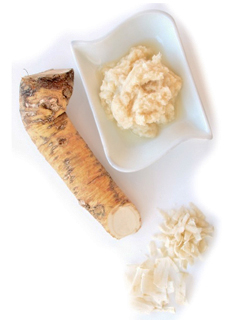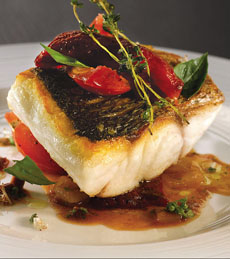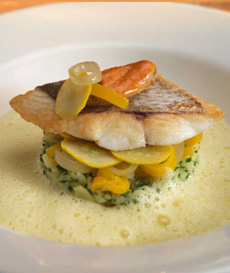
Horseradish root, grated root and prepared
horseradish (in dish). Photo courtesy
Microplane. |
|
While Americans are piling on the hot sauce, they’re overlooking horseradish—a different kind of hot and spicy.
Horseradish, Amoriacia rusticana, is a pungent root vegetable with a long history of culinary and medicinal uses. Popular among ancient Greeks and Romans, this Old World food was favored by early healers for treating sore throats and digestive upsets.
Horseradish is a member of the cruciferous family of vegetables (Brassicaceae) and pairs well with its “cousins”: arugula, bok choy, broccoli, Brussels sprouts, cauliflower, cabbage, collard greens, cress, kale, kohlrabi, mizuna (a variety of mustard green), radish, rapini (broccoli rabe), rutabaga, tatsoi (also called rosette bok choy, spinach mustard or spoon mustard) and turnip.
Where Does Wasabi Fit In?
Wasabi (Wasabia japonica), a type of horseradish served with sushi, is another cousin. Wasabi has more complex flavors, is more difficult to grow and is accordingly far more expensive. SPOILER: Unless you’re in a super-high-end sushi bar, you’re getting conventional horseradish, mixed with mustard and colored green to look like wasabi. Here’s the scoop.
|
Today, horseradish is usually grated and mixed with vinegar, cream or mayonnaise to make condiments or sauces. On the medicinal side, its volatile compounds are being studied as anti-carcinogens.
The roots can be found in most produce sections, and prepared horseradish is sold in jars in the refrigerator case. We always have a jar of prepared horseradish at hand (actually two jars—regular and beet flavored). But those who want the sharpest bite will grate it fresh from the root.
GRATE YOUR OWN
If you don’t already have a fine grater, take a look at the fine grater from Microplane’s Artisan Series. You can quickly grate horseradish into fine pieces, ready to blend. And of course, it can grate anything else, from cheeses to onions to citrus zest. You can purchase one where fine kitchen gadgets are sold, or online, for an SRP of $9.95.
HOW TO USE HORSERADISH
Most Americans eat the majority of their horseradish in cocktail sauce (make your own by combining prepared horseradish with chili sauce or ketchup).
But here’s what else you can do with it:
Bread: Instead of garlic bread, make “horseradish bread”: blend with softened butter and fresh herbs, spread on sliced bread and broil.
Condiments: Mix with mayonnaise for a great sandwich spread), make an even spicier mustard.
Dips: Add to sour cream or Greek yogurt; add a splash to guacamole.
Salads: Add to dressings, cole slaw, potato salad and the “protein salads”: chicken, egg, tuna, etc.
Sauces: Add horseradish to sour cream or crème fraîche for a fish sauce or to give a kick to marinara sauce. An easy horseradish cream sauce for beef: sour cream blended to taste with horseradish, Dijon mustard, Worcestershire sauce, salt, pepper, garlic powder, and white wine vinegar.
Soups and stews: horseradish pairs famously with beef and seafood, but try it with vegetable and other soups.
More: Once you try horseradish mashed potatoes, you’ll be hooked (you can also mix some into twice-baked potatoes or potato pancakes); ditto for beet salad, or in a sour cream sauce with any beets. Also: deviled eggs, horseradish crusts, mac and cheese, smoked salmon and of course, Bloody Marys.
|
|
RECIPE: CRANBERRY-BEET HORSERADISH
Make this delicious, quick and easy condiment and use it with vegetables and cheeses. The tannins in cranberries and beets work well with a complex, aged Cheddar and other semihard cheeses (we also enjoyed it with soft goat cheese), while the spiciness of horseradish cuts the creaminess.
Ingredients
1 can (16 ounces) whole cranberry sauce
1 jar (6 ounces) prepared beet horseradish
Sea salt, to taste
Optional: 1 to 2 tablespoons light brown sugar
Preparation
1. COMBINE the cranberry sauce and horseradish. Add salt to taste. Chill and serve alongside cheese.
2. OPTIONAL: For a sweeter relish, add the brown sugar.
|
|

Cranberry-beet horseradish is a delicious cheese condiment. Photo courtesy Wisconsin Milk Marketing Board.
|
|
A WHOLE HORSERADISH FESTIVAL
Since 1987, the International Horseradish Festival in Collinsville, Illinois has celebrated the root with food food and fun activities.It’s held the first weekend in June.
|
|








